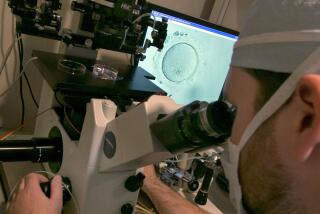From Our Blogs
HERO COMPLEX
2 weeks for 2 minutes of movie
Early in âTerminator Salvation,â Christian Bale as future resistance leader John Connor leads a raid on a Skynet facility, escapes in a helicopter, gets walloped by the force of a nuclear explosion, crash-lands and crawls from the wreckage, only to get attacked by a crawling Terminator. Did we mention this is all in one shot? To achieve this, visual effects supervisor Charles Gibson coordinated two film crews working over multiple locations to compile all the elements of the scene. âThis sequence was extremely complicated,â Gibson says.
The shot begins on a back lot in Albuquerque, with Bale crawling out of a hole. A whip-pan shot blurs the transition to the helicopter suspended from a construction crane in front of a blue screen. As Bale runs to the helicopter and grabs the control stick to take off, the background shows a miniature of the facility. The model was then blown up, switching the view to that of a computer-generated helicopter buffeted by the force of a nuclear explosion.
As the camera pushes back into the cockpit, the scene seamlessly transitions to a hand-held camera take of Bale struggling with the controls. The helicopter, meanwhile, is on a rig thatâs spinning it around. When the helicopter crashes, weâre shown a new helicopter already arranged in crash position, with a stunt man in Baleâs seat. After he unhooks himself and falls to the roof of the cockpit, Bale picks up the action, crawling out of the helicopter in time to see a mushroom cloud and be grabbed by the Terminator lying in wait.
âIt was one of the most-planned sequences of the movie,â Gibson says of the two-week shoot (for two minutes of screen time). âWe try to leave a little bit of breathing room. You get a much more fluid execution and you donât feel the phases of the shot as you move through them.â
-- Patrick Kevin Day
From: Hero Complex: For your inner fanboy; News on genre films, graphic novels and science fiction
For more, go to latimes.com/herocomplex
CULTURE MONSTER
A Monty Python revival in L.A.
Bring out your dead!
The British comedy pranksters are back -- sort of.
A new theatrical production of Monty Python-esque sketches, titled âAn Evening Without Monty Python,â will play at the Ricardo Montalban Theatre in Hollywood for 10 performances Sept. 23 to Oct. 4.
The production will then move to New York for a run of five performances at the Town Hall Oct. 6-10.
Eric Idle, one of the founding members of Monty Pythonâs Flying Circus, will direct the show (along with B.T. McNichol).
The cast includes non-Python actors Hank Azaria, Jane Leeves, Alan Tudyk, Rick Holmes and Jim Piddock.
The 80-minute show will consist of short musical numbers and skits from past Python productions that were originally created by Idle, John Cleese, Graham Chapman, Terry Gilliam, Terry Jones and Michael Palin.
The production is also meant to promote the publication of the book âMonty Python Live!,â which commemorates the troupeâs 40-year history.
And maybe thereâs a little more marketing synergy to be had with the national tour of âMonty Pythonâs Spamalot,â which happens to be playing at the Ahmanson Theatre July 7 to Sept. 6.
-- David Ng
From: Culture Monster: All the arts, all the time
For more, go to latimes.com/culturemonster
BOOSTER SHOTS
Recession hits IVF treatments
The turn of the century saw a huge burst of babies, worldwide, conceived with assisted reproductive technologies, such as in vitro fertilization, according to a new study. But, in the United States, infertility treatments are down due to the recession, according to some reports.
A study published Thursday in the journal Human Reproduction found that assisted reproductive technologies, or ART, increased 25% worldwide between 2000 and 2002. An estimated 219,000 to 246,000 babies are born each year worldwide from ART procedures.
The study also found a large increase in the use of intracytoplasmic sperm injection, a procedure where a sperm is injected into an egg in the lab to create an embryo, in all countries, ranging from 61% of IVF procedures in the United States to 92% in the Middle East.
The authors of the report, from the International Committee for Monitoring Assisted Reproductive Technology, noted that access to IVF varies widely among nations and that low-cost procedures should be more available to couples in poor countries.
Cost issues, however, are not limited to poor nations. A recent story in the New York Post found that a number of infertility clinics in the United States are experiencing a decline in patients and some may be struggling to stay afloat.
ART procedures were expected to decline this decade as the last of the baby boomers exit their reproductive years, according to a blog post from the Center for Human Reproduction, a New York City clinic. The loss of jobs, and health insurance, has further reduced patients seeking IVF. And, the blog notes, in a recession, fewer families consider having a baby.
-- Shari Roan
From: Booster Shots: Oddities, musings and news from the world of health
For more, go to latimes.com/boostershots
More to Read
Only good movies
Get the Indie Focus newsletter, Mark Olsen's weekly guide to the world of cinema.
You may occasionally receive promotional content from the Los Angeles Times.










